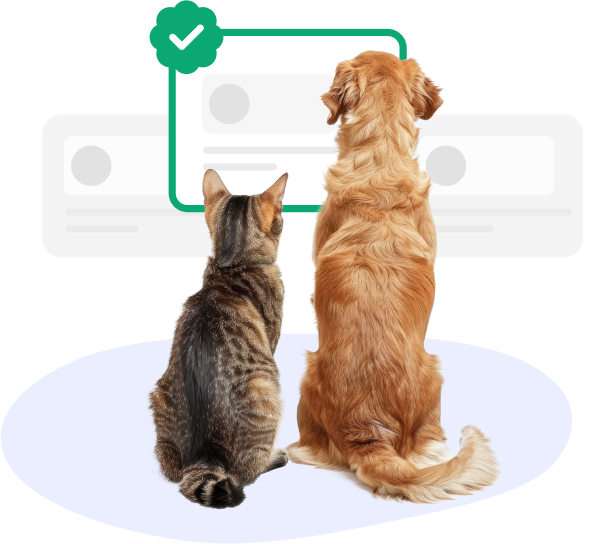What Is Pet Insurance?
Pet insurance is health insurance for your dog and cat. If your pet needs emergency care from an unexpected accident or illness, it can help cover the expensive vet bill. Some providers offer additional coverage for routine and preventative care to keep your pet healthy between vet trips.
Know Before You Enroll: Waiting Periods
Pet insurance typically has a waiting period before coverage for accidents and illnesses begins. This period varies across providers and coverage types. For instance, if a plan has a 14-day waiting period, a pet's vet visit within 3 days of signing up will not be covered. Additionally, if a pet shows signs of illness during the waiting period, even if the plan is already in place, the illness will not be covered.
What Does Pet
Insurance Cover?
Pet insurance covers the costs of diagnosing and treating unexpected accidents and illnesses. Think anything from your dog swallowing a sock to comprehensive cancer treatment for your cat.
Accident Coverage
A standard pet insurance plan for dogs and cats typically includes the following:
- Alternative Therapy
- Broken Bones
- Cuts
- Dental Accidents
- Emergency Care
- Hospitalization
- Poisoning
- Prescription Medication
- Surgery
- Swallowed Objects
Illness Coverage
A standard pet insurance plan for dogs and cats typically includes the following:
- Allergies
- Breed-specific Conditions
- Cancer
- Chronic Conditions
- Diabetes
- Diagnostics
- Diarrhea
- Prescription Medication
- Skin Conditions
- Vomiting
Add-Ons
In addition to their base plan, some pet insurance providers offer optional coverage add-ons like these:
- Emergency Transportation
- Exam Fees
- Hospital Boarding Fees
- Microchipping
- Prescription Food
- Preventative Care
What Does Pet
Insurance Not Cover?
Pet insurance covers a lot but there are some limitations. While coverage varies by provider, most pet insurance plans do not cover the following in their base plan.
Common Exclusions
Depending on the provider, the following conditions are typically not covered or are offered as an add-on.
*Unless you add a separate wellness plan
We make it easy for you to know what coverage you’re getting. Get a quote below to compare coverage from multiple providers all in one place.
Compare Quotes
How Does Pet Insurance Work?
Pet insurance is like health insurance for people, providing peace of mind and support for unexpected medical bills. Unlike human health insurance, pets aren't restricted by in-network providers and can visit any licensed vet in the U.S.
Pet insurance usually works on a reimbursement model. You pay the bill, submit a claim, and get reimbursed. Claims must be filed within a specific time frame, varying by provider. Some insurers pay the vet directly, saving you from upfront costs and filing claims.
Common Dog Insurance Terms
Annual Limit
This is the maximum amount your insurance policy will pay for covered veterinary expenses within a single year. Consider this limit when choosing a plan to ensure your pet's healthcare needs are adequately covered throughout the year.
Claims
Expiration
This is the amount of time you have to submit a claim with a provider to get reimbursed for covered costs. It varies by provider.
Co-Insurance
Sometimes called 'reimbursement rate,' this is the percentage that your pet insurance provider will reimburse you for the total cost of eligible conditions treated by a veterinarian after your deductible is met.
Deductible
This is the amount you will pay out of pocket for veterinary expenses before your insurance coverage kicks in. Choosing the right deductible helps balance your monthly premium and potential out-of-pocket costs, ensuring your pet's health is protected without straining your finances. Some deductible options providers offer can be as low as $0 or as high as $1,000.
Direct Billing
Sometimes called Direct Vet Pay, the insurance company pays the veterinarian for eligible pet medical expenses. This process spares the pet owner from paying the entire bill upfront and seeking reimbursement later.
Monthly
Premium
This is the monthly fee you pay for pet coverage. Your monthly premium will go up as your pet ages.
Reimbursement
Rate
Sometimes called 'co-insurance,' this is the portion of your eligible veterinary expenses that your insurance provider pays you back after you've met your deductible. This percentage determines how much of your vet bills will be covered by your insurance plan. Most providers have options between 70% to 90%.
Sub-Limits
This is the maximum amount a provider will pay for certain coverage or conditions within a policy period. This helps them manage risk and keep premiums affordable. Sub-limits vary by provider (and not all providers have them) so, always be sure to read sample policies closely for these limits.
Waiting Period
This is the amount of time you will need to wait for your coverage to become effective. It also indicates how long you’ll have to wait to file claims for your pet’s healthcare expenses.
Read our full list of pet insurance terms and definitions for more.

When Is The Best Time To Get Pet Insurance?
The earlier, the better. Most providers have a minimum enrollment age between 6-8 weeks old, but you can enroll a pet in a pet insurance plan at any stage of their life.
We recommend signing up for pet insurance when they’re young and healthy for a few reasons:
You can ensure treatment for hereditary conditions if your pet is diagnosed with one later.
Younger pets cost less to insure. Getting coverage now can save you big rather than signing up when they’re older.*
Pre-existing conditions aren’t covered. Enrolling your pet early and getting a clean bill of health from the vet means any covered conditions they didn’t show signs of before are eligible for coverage.
Puppies and kittens are curious and love exploring, making them prone to accidents, like eating something they shouldn’t. Pet insurance, like any insurance, provides peace of mind for the unexpected.
Emergency veterinary care can cost thousands of dollars. Most pet owners don’t realize how expensive an emergency visit is until they’re faced with the bill or, in some cases, a hard decision to make at the veterinary hospital.
Adding wellness coverage to your pet insurance plan is a great way to round out your young pet’s protection. During the first few years of their lives, you’ll probably visit the vet more often for exams, vaccines, or even a spay or neuter. The routine and preventative care that come with wellness coverage can help cover the costs for all these things and more.
* Note: Regardless of your pet’s age when they were originally insured, the price of coverage will likely rise as it gets older.
How Much Is Pet Insurance?
Pet insurance rates are regulated and filed by insurers with your state’s Department of Insurance. This means that, for a specifically configured policy, the rate you’re quoted from an insurer will be the same for your pet, regardless of where you purchase that policy. That said, the rates will vary between insurers and will vary based on the following factors:

Location
The cost of veterinary care in your area may be more or less expensive than in another area.
Type of pet
In most cases, dogs are more expensive than cats.
Breed
The breed of your pet can affect pricing, especially if they’re prone to developing any breed-specific conditions that will need veterinary care down the line.
Age
Older pets cost more to insure than younger pets since they’re more prone to accidents and illnesses. That’s why we recommend insuring your pet as soon as you can.
Deductible
How much of a yearly deductible you’re willing to pay will affect pricing. A higher deductible will lower your overall price, but you’ll have to pay more out of pocket before your insurance reimburses you.
Reimbursement
How much you’d like to be paid back will affect pricing. A lower reimbursement rate will bring down your overall price, but you might have to take more financial responsibility for your pet’s care.
Coverage add-ons
Any add-ons you choose to boost your base plan will raise your overall cost.







